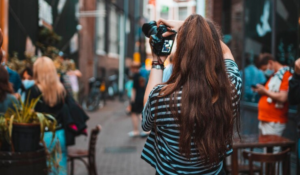Fine Art Photography: A Complete Guide

Fine art photography is an artistic expression that goes beyond mere documentation. It explores the artist’s inner vision, and their emotions. Fine art photography places more emphasis on the photographer’s creative vision and perspective, elevating it to a form visual art. This comprehensive guide will cover the basics of fine art photography. From its definition to tips for aspiring photographers, it is a complete look at this form of visual art.
Fine Art Photography Definition
Fine art photography involves more than simply capturing images. It’s about incorporating personal expression, emotions, and narratives into each photograph. From composition to post-processing it involves deliberate artistic decisions aimed at conveying concepts and evoking emotional responses in the viewer. Fine art photography differs from other types of photography in that it emphasizes the artist’s creative vision and perspective, transcending simple documentation.
Vision and Inspiration
For fine art photographers, developing a vision that is unique is crucial. Understanding what you want to say and being able express it visually is part of vision. Finding inspiration is difficult but essential to developing one’s own artistic voice. Fine art photographers need to cultivate an eye for beauty and significance in the world, whether they draw inspiration from everyday life, nature, or their own personal experiences.
Create a Unique Body Of Work
Fine art photography is characterized by a strong body of work that revolves around a consistent theme, message and style. The impact of fine art projects is influenced by the consistency and depth of subject matter, shooting technique, and post-processing. Every aspect of the creative processes, from conceptualizing ideas to executing with precision, plays a crucial role in shaping an impressive portfolio.
Learn from the Masters
For aspiring fine-art photographers, studying the work of famous photographers can be invaluable. It’s important to learn from the masters, but it’s also vital to be innovative and not just imitate them. This will allow your unique voice to come through. Analyzing the styles, techniques and concepts used by master photographers can help aspiring artists gain insight into the craft. They can also refine their own approach towards fine art photography.
Stepping out of comfort zones
Fine art photography can be enriched by exploring new genres and styles of shooting. By embracing discomfort and trying out different approaches, you can expand your artistic horizons. You will also improve your photographic skills. Stepping out of your comfort zone can encourage artistic exploration and innovation.
Prepare for Public Display
In order to showcase your work in the fine art photography world, you must establish an online presence. You should also network with other photographers. Instagram and other social media platforms are powerful tools to connect with fellow artists and audiences. Mastering the art and technique of presentation is also essential to gaining attention from viewers.
Mastering Post-Processing
Digital post-processing skills are essential for fine art photography, because they enhance creative freedom and allow artists to fully realize their artistic vision. Understanding post-processing techniques is essential for photographers, whether they use software such as Capture One Pro, Adobe Photoshop or other programs. It allows them to enhance and transform their images to bring their artistic visions to life.
Embracing Printing
Printing is a fundamental part of fine art photography. It allows for the tangible expression of an artist’s vision. By familiarizing yourself with the various printing techniques and papers, you can elevate the presentation of your fine art prints and ensure that they accurately communicate the intended message. Mastering the art and science of printing, from choosing the best paper to working with professional printers is crucial for fine art photographers.
Engagement with Galleries
To build relationships with galleries, it is important to do thorough research on each gallery and understand their aesthetics and focus. Although gaining gallery representation can take some time, cultivating relationships and submitting your work professionally is essential for gaining recognition and exposure in the fine arts world. Artists can reach a wider audience by exhibiting their work in reputable exhibitions and galleries. They will also establish themselves as serious fine art photographers.
The Business Aspect
Fine art photography requires patience, resilience and a long term perspective. Rejection and setbacks will always happen, but perseverance and reflection are the keys to success and growth in this industry. Fine art photographers who are proactive in their marketing, networking and self-promotion can successfully navigate the business side of their practice without compromising their artistic vision.
Diversifying income streams
While pursuing fine arts projects, generating additional income streams such as teaching workshops or commercial photography can provide financial stability. The photography industry can be sustainable if artists balance their artistic goals with practical concerns. This allows them to follow their passions while still supporting themselves.
Maintaining Professionalism
Maintaining professionalism in every aspect of your practice, including pricing prints and engaging with clients and gallery, will foster credibility and trust within the fine art community. Clarity in communication, adherence to standards and ethical business practices enhances the reputation of the artist and leads to success over the long term.
Nurturing Passion
Rekindling the passion you had for photography will fuel artistic pursuits and maintain creative momentum in fine-art photography. Cultivating love for the craft will ensure continued growth and satisfaction in the journey of exploration. Fine art photographers who embrace their creativity and stay true to their passion can produce meaningful work that is appreciated by audiences all over the world.
Fine art photography offers endless possibilities for exploration and expression. It is a discipline that blends technical skills with artistic vision. Fine art photographers are instrumental in shaping the way we see the world. Fine art photographers can enjoy a rewarding journey through self-discovery, innovation and dedication by embracing these three qualities.



